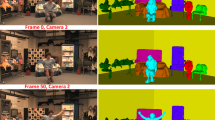Abstract
This paper proposes a quasi-dense reconstruction from uncalibrated sequence. The main innovation is that all geometry is computed based on re-sampled quasi-dense correspondences rather than the standard sparse points of interest. It not only produces more accurate and robust reconstruction due to highly redundant and well spread input data, but also fills the gap of insufficiency of sparse reconstruction for visualization application. The computational engine is the quasi-dense 2-view and the quasi-dense 3-view algorithms developed in this paper. Experiments on real sequences demonstrate the superior performance of quasi-dense w.r.t. sparse reconstruction both in accuracy and robustness.
Chapter PDF
Similar content being viewed by others
Keywords
These keywords were added by machine and not by the authors. This process is experimental and the keywords may be updated as the learning algorithm improves.
References
P. Beardsley, P. Torr, and A. Zisserman. 3D model acquisition from extended image sequences. ECCV’96.
D.C. Brown. The bundle adjustment — progress and prospects. International Archive of Photogrammetry, 21, 1976.
D.D. Morris, K. Kanatani and T. Kanade. Uncertainty modeling for optimal structure from motion. In ICCV’99 Workshop Vision Algorithms: Theory and Practice.
F. Devernay and O. Faugeras. Automatic calibration and removal of distortion from scenes of structured environments. Proceedings of the spie Conference on Investigate and Trial Image Processing, San Diego, California, USA, volume 2567.
O. Faugeras. What can be seen in three dimensions with an uncalibrated stereo rig? ECCV’92.
O. Faugeras and Q.T. Luong, The Geometry of Multiple Images The MIT Press, 2001.
M.A. Fischler and R.C. Bolles. Random sample consensus: A paradigm for model fitting with applications to image analysis and automated cartography. Graphics and Image Processing, 24(6):381–395, June 1981.
A.W. Fitzgibbon, G. Cross, and A. Zisserman. Automatic 3d model construction for turn-table sequences. SMILE’98.
A.W. Fitzgibbon and A. Zisserman. Automatic camera recovery for closed or open image sequences. ECCV’98.
P. Fua. Combining stereo and monocular information to compute dense depth maps that preserve discontinuities. IJCAI’91.
C. Gauclin and T. Papadopoulos. Fundamental matrix estimation driven by stereo-correlation. ACCV’00.
C. Harris and M. Stephens. A combined corner and edge detector. Alvey Vision Conference, 1988.
R.I. Hartley, R. Gupta, and T. Chang. Stereo from uncalibrated cameras. CVPR’92.
R.I. Hartley. Euclidean Reconstruction from Uncalibrated Views. DARPA-ESPRIT Workshop on Applications of Invariants in Computer Vision, 1993.
R.I. Hartley and A. Zisserman. Multiple View Geometry in Computer Vision. Cambridge University Press, June 2000.
A. Heyden, Geometry and Algebra of Multiple Projective Transformations. PhD. Thesis, Lund Institute of Technology, Sweden, December 1995.
M. Irani, P. Anandan, and S. Hsu. Mosaic based representations of video sequences and their applications. ICCV’95.
T. Kanade, P.J. Narayanan, and P.W. Rander. Virtualized reality: Concepts and early results. Workshop on Representation of Visual Scenes, June 1995.
K. Kanatani. Statistical Optimisation for Geometric Computation: Theory and Pra. Elsevier Science, 1996.
Y. Kanazawa and K. Kanatani. Do we really have to consider covariance matrices for image features ? ICCV’01.
S. Laveau. Géométrie d’un système de N caméras. Théorie, estimation, et applications. PhD Thesis, École Polytechnique, France, May 1996.
M. Lhuillier and L. Quan. Image interpolation by joint view triangulation. CVPR’99.
M. Lhuillier and L. Quan. Robust Dense Matching Using Local and Global Geometric Constraints. ICPR’00.
M. Lhuillier and L. Quan. Match propagation for image-based modeling and rendering. IEEE Trans. on PAMI, 2002.
B.D. Lucas and T. Kanade. An iterative image registration technique with an application to stereo vision. IJCAI’81.
Manual of Photogrammetry, Fourth Edition. American Society of Photogrammetry and Remote Sensing, 1980.
P. F. McLauchlan. Gauge independence in optimization algorithms for 3D vision. Proceedings of the Vision Algorithms Workshop, 2000.
D. Nister. Reconstruction from uncalibrated sequences with a hierarchy of trifocal tensors. ECCV’00.
Y. Ohta and T. Kanade. Stereo by intra and inter-scanline search using dynamic programming. IEEE Trans. on PAMI, 7(2):139–154, 1985.
M. Pollefeys, R. Koch, and L. Van Gool. Self-calibration and metric reconstruction in spite of varying and unknown internal camera parameters. ICCV’98.
M. Pollefeys, R. Koch, M. Vergauwen, and L. Van Gool. Metric 3d surface reconstruction from uncalbrated image sequences. SMILE’98.
W.H. Press, S.A. Teukolsky, W.T. Vetterling, and B.P. Flannery. Numerical Recipes in C, The Art of Scientific Computing. Cambridge University Press, 1992.
L. Quan. Invariants of six points and projective reconstruction from three uncalibrated images. IEEE Trans. on PAMI, 17(1):34–46, January 1995.
F. Schaffalitzky, A. Zisserman, R. Hartley, and P.H.S. Torr. A six point solution for structure and motion. ECCV’00.
A. Shashua. Trilinearity in visual recognition by alignment. ECCV’94.
P. Sturm and B. Triggs. A factorization based algorithm for multi-image projective structure and motion. ECCV’96.
H.S. Sawhney H. Tao and R. Kumar. A global matching framework for stereo computation. ICCV’01.
C. Tomasi and T. Kanade. Shape and motion from image streams under orthography: A factorization method. IJCV, 9(2):137–154, November 1992.
P.H.S. Torr and D.W. Murray. The development and comparison of robust methods for estimating the fundamental matrix. IJCV, 24(3):271–300, 1997.
P.H.S. Torr and A. Zisserman. Robust parameterization and computation of the trifocal tensor. IVC, 5(15):591–605, 1997.
B. Triggs. Autocalibration and the Absolute Quadric. CVPR’97.
B. Triggs, P.F. McLauchlan, R.I. Hartley, and A. Fitzgibbon. Bundle ajustment — a modern synthesis. Vision Algorithms: Theory and Practice, 2000.
Z. Zhang, R. Deriche, O. Faugeras, and Q.T. Luong. A robust technique for matching two uncalibrated images through the recovery of the unknown epipolar geometry. AI, 78(1–2):87–119, 1994.
Author information
Authors and Affiliations
Editor information
Editors and Affiliations
Rights and permissions
Copyright information
© 2002 Springer-Verlag Berlin Heidelberg
About this paper
Cite this paper
Lhuillier, M., Quan, L. (2002). Quasi-Dense Reconstruction from Image Sequence. In: Heyden, A., Sparr, G., Nielsen, M., Johansen, P. (eds) Computer Vision — ECCV 2002. ECCV 2002. Lecture Notes in Computer Science, vol 2351. Springer, Berlin, Heidelberg. https://doi.org/10.1007/3-540-47967-8_9
Download citation
DOI: https://doi.org/10.1007/3-540-47967-8_9
Published:
Publisher Name: Springer, Berlin, Heidelberg
Print ISBN: 978-3-540-43744-4
Online ISBN: 978-3-540-47967-3
eBook Packages: Springer Book Archive




